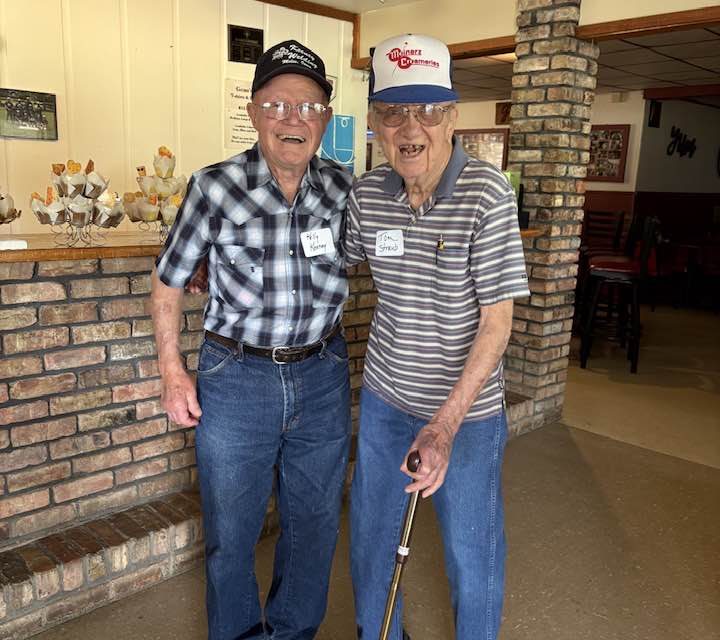
Dick Kunau, local historian generously displayed many of the creamery related items from his collection.

Eric Leslie and Rose Eggers. Eric got emotional seeing his longtime co-worker, Rose.

Kelly Keeney and Tom Straub! These two have been looking forward to this party for five months!

Becky Bormann, Susan Kuhlman, Jan Keeney and Archene Luskey.
by Caroline Bredekamp for the Preston Times
A Meinerz Creamery/Beatrice Foods Reunion was held at Geno’s Pizza in Preston on Saturday, June 7th. Any past employees or milk haulers and their families connected with the Creamery were invited to attend and share their stories. Dick Kunau, local historian generously displayed many of the creamery related items from his collection.
The Dairy Industry’s Impact on Preston History
(A portion of creamery history being written for the 150-Year Celebration of Preston, a joint effort of Dick Kunau, Sheryl Ringen, and Donald Wentworth)
At one time Preston Butter was considered to be the best butter in this area, although the creamery at Spragueville made butter too and was a strong competitor to the Farmer’s Co-Op Creamery in Preston. It was a booming business. In 1948 the Preston plant produced a total of one million, one hundred and ninety-nine thousand, six hundred and fifty-two pounds of butter from sweet cream. The total receipts for that year were $953,003.96. This was very different from1903 when it produced 136,908 pounds which brought $27,867.
Farmers’ milk came into the creamery where the cream was separated by several large separators which were run by a large steam engine with a line shaft that drove belts which turned the separators. This steam engine also churned the cream into butter. Farmers could take the buttermilk home for the hogs where they mixed ground oats or barley with it to make slop for the pigs.
The product of the Preston creamery was one-pound blocks of butter well into the 1960’s. Large stainless-steel drums churned the golden butter until it was just right. Then it went through the butter wrapper machine, which formed the solid blocks and wrapped them in paper and boxed them.
In 1965 the Farmer’s Co-Op board voted to sell their business to Meinerz Creameries, which became a division of Beatrice Foods Co. in 1974. At the time of the purchase, they closed their Maquoketa plant and moved to Preston where they specialized in production of pizza cheese.
Expansion included purchase of the creamery at LaMotte and hauling that milk supply to Preston. With the increase they then purchased Badrick’s John Deere business building east of the plant, built a facility to dry skim milk and sold the powdered milk. Later they purchased the former Kling building on the corner of Mitchell and Gillett Streets for storage.
According to a letter written to Terry Feller by Archie Meinerz in 1980, fifteen years of building, remodeling, and expansion resulted in a large modern plant able to process between 15 and 18 million pounds of milk per month working five to six days per week.
In 1980 they employed approximately sixty employees and specialized in making mozzarella, provolone, and hard cheeses that were shipped to about 43 of the states on their own fleet of trucks. By this time milk was shipped from farmers to the plant in bulk tanks instead of the former 10-gallon cans. In 1980 they could process about 40,000 pounds of milk per hour, and produce about 4,000 pounds of cheese per hour.
Times were changing. More and more farmers were cutting back on livestock and increasing their crop sales. Getting out of the milk business and time-consuming chores freed up more time for field work. Fewer acres needed for pasture and hay for the cows meant more acres for cash crops. The drop in locally produced milk contributed to the Meinerz decision to close the Preston plant and truck milk to their plant at Fredricksburg. This was the end of a long run of big business right in the heart of Preston.
In addition to butter and cheese, households needed milk and there were several door-to-door milk delivery businesses over the years. We know a little of Mollenhof, Elmer Yaddof, and Keith Anderson. The Old City Hall Museum has several Mollenhof items. We would like to know more about these and any others who kept up the daily milk supplies to Preston families.
The market for milk and dairy products is being met by a few very large dairies, instead of the hundreds of small farmers from long ago. Cows in these herds number the thousands instead of the twenty and thirty of days gone by. For better or worse, that’s the way it is. Still, this month we salute all those farmers, milk haulers, butter makers and cheese makers that were the heartbeat of our community for so many years.

